|
Numerical Study on Internal Flow Field of Hydrocyclone
CUI Baoyu, WEI Dezhou, ZHAI Qingxiang, ZHANG Siyao
2014, 35 (6):
894-897.
DOI: 10.12068/j.issn.1005-3026.2014.06.030
By using RSM(Reynolds stress model)turbulence model and VOF(volume of fluid)twophase flow model, systematic numerical study on internal flow field of 50 mm hydrocyclone was carried out, which had been validated by PIV(particle image velocimetry)measurement results. It shows that internal static pressure of hydroclone gradually declines from wall to center, the static pressure is zero at the boundary of air core, the interior of air core is negative pressure, and additional energy is consumed by air core when the hydrocyclone works. Tangential velocity distribution could be regarded as a combined vortex, inside is forced vortex and outside is quasifree vortex. The envelope of zero vertical velocity is a turning surface of axial velocity change, its upside is cylinder and its lower part is cone. The diameter of the cylindrical section is 23 times as large as overflow outlet diameter. Radial velocity direction is from the wall of the hydrocyclone toward the center in the outer vortex area, radial velocities of opposite direction and relative position exist in the inner vortex area, and radial velocity inside air core is almost zero.
References |
Related Articles |
Metrics
|

